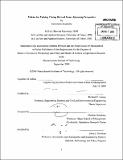| dc.contributor.advisor | Richard C. Larson. | en_US |
| dc.contributor.author | Sasanuma, Katsunobu | en_US |
| dc.contributor.other | Massachusetts Institute of Technology. Operations Research Center. | en_US |
| dc.date.accessioned | 2010-10-12T16:21:41Z | |
| dc.date.available | 2010-10-12T16:21:41Z | |
| dc.date.copyright | 2009 | en_US |
| dc.date.issued | 2009 | en_US |
| dc.identifier.uri | http://hdl.handle.net/1721.1/59117 | |
| dc.description | Thesis (S.M. in Technology and Policy)--Massachusetts Institute of Technology, Engineering Systems Division, Technology and Policy Program; and, (S.M.)--Massachusetts Institute of Technology, Sloan School of Management, Operations Research Center, 2009. | en_US |
| dc.description | Cataloged from PDF version of thesis. | en_US |
| dc.description | Includes bibliographical references (p. 89-93). | en_US |
| dc.description.abstract | Drivers in urban neighborhoods who cruise streets, seeking inexpensive on-street parking create a significant fraction of measured traffic congestion. The solution to this problem is to reduce the total traffic volume including cruising traffic by implementing a congestion pricing scheme: the imposition of a usage fee on a limited-capacity resource during times of high demand. We review the history of two alternatives for implementing the scheme: road pricing, which involves cordoning off a section of the center city and imposing a fee on all vehicles that enter it; and parking pricing, which increases the costs of on-street and perhaps off-street parking. We find that parking pricing is often a needed companion to road pricing, since in many environments a significant fraction of drivers are simply cruising, looking for inexpensive on-street parking. However, the effectiveness of parking pricing is difficult to analyze quantitatively because vehicles cruising for parking are not clearly distinguishable from other vehicles. We view that the pool of drivers cruising at any time can be modeled as a queue, where 'queue service' is the act of parking in a recently vacated parking space and queue discipline is SIRO - Service In Random Order. We develop a queueing model of such driver behavior, allowing impatient drivers to abandon the queue and to settle for expensive off-street parking. We then relate the model to the economic theory of congestion pricing, arguing that price differentials between on-street and off-street parking should be reduced in order to reduce traffic congestion. Using the "Parking Queue" model and collected data, we estimate that less than half of cruising drivers successfully find a vacant spot and the number of cruising vehicles is 10-20% of the total number of parking spaces during peak hours in the most congested area in Boston. | en_US |
| dc.description.statementofresponsibility | by Katsunobu Sasanuma. | en_US |
| dc.format.extent | 89 p. | en_US |
| dc.language.iso | eng | en_US |
| dc.publisher | Massachusetts Institute of Technology | en_US |
| dc.rights | M.I.T. theses are protected by
copyright. They may be viewed from this source for any purpose, but
reproduction or distribution in any format is prohibited without written
permission. See provided URL for inquiries about permission. | en_US |
| dc.rights.uri | http://dspace.mit.edu/handle/1721.1/7582 | en_US |
| dc.subject | Engineering Systems Division. | en_US |
| dc.subject | Technology and Policy Program. | en_US |
| dc.subject | Operations Research Center. | en_US |
| dc.title | Policies for parking pricing derived from a queueing perspective | en_US |
| dc.type | Thesis | en_US |
| dc.description.degree | S.M. | en_US |
| dc.description.degree | S.M.in Technology and Policy | en_US |
| dc.contributor.department | Massachusetts Institute of Technology. Engineering Systems Division | en_US |
| dc.contributor.department | Technology and Policy Program | en_US |
| dc.contributor.department | Massachusetts Institute of Technology. Operations Research Center | en_US |
| dc.contributor.department | Sloan School of Management | |
| dc.identifier.oclc | 657643468 | en_US |
